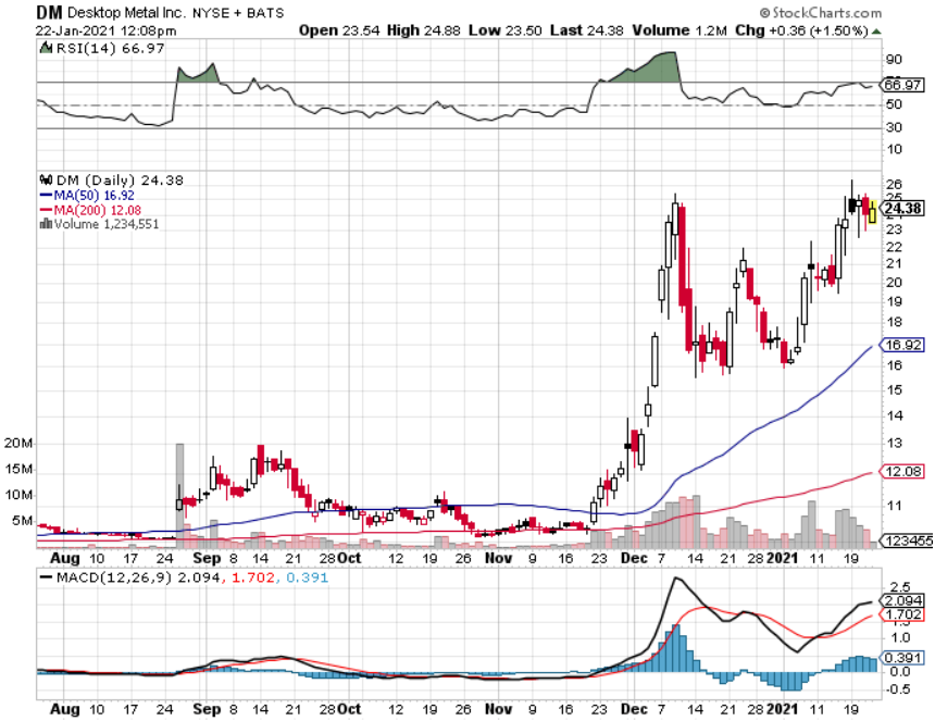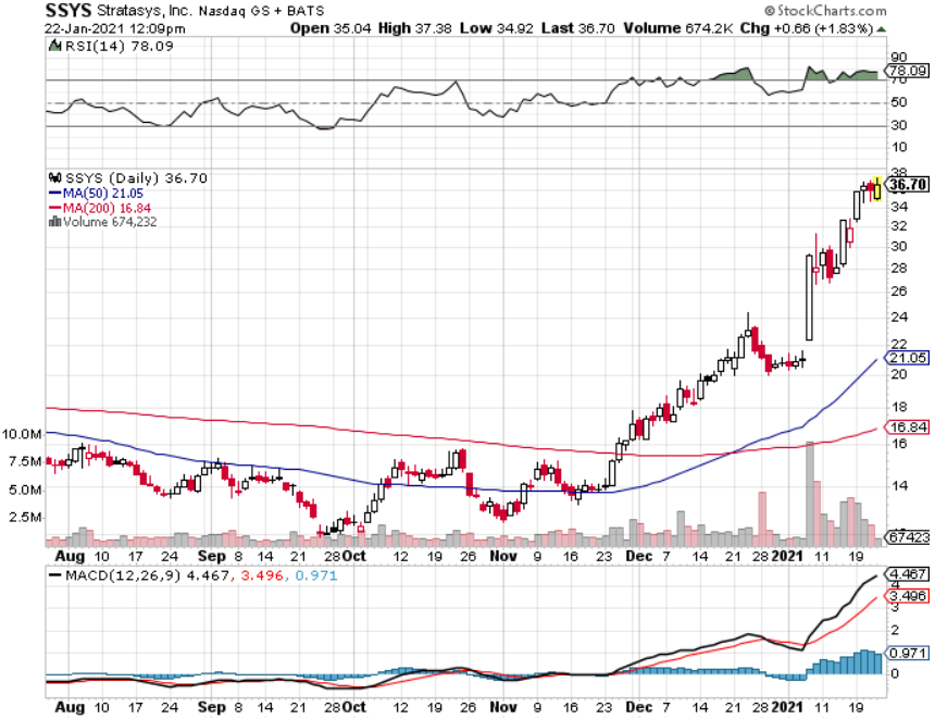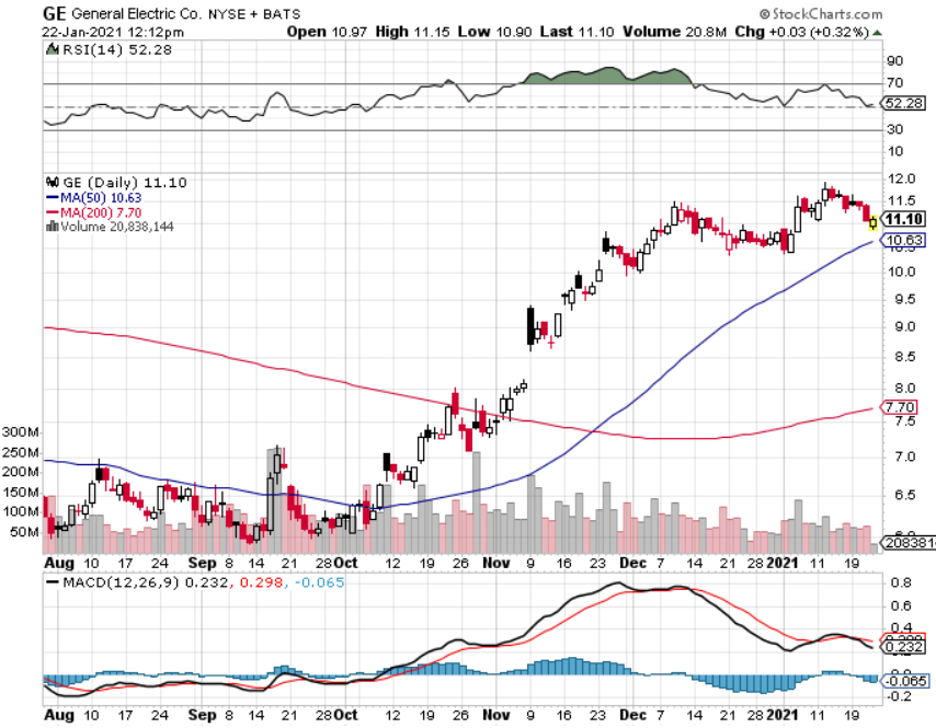Desktop Metal (DM) produces metal and carbon fiber 3D printing accessible to all engineers, designers, and manufacturers.
I’ve dipped my toe in this industry before by recommending Stratasys Ltd. (SSYS) whose stock has tripled from October 2020.
Since its inception, the company has been a happy recipient of generous funding channels and attracted total funding of $438M, always a good start.
Desktop Metal is truly well-capitalized after its SPAC transaction and strategically positioned to reap the rewards from a "dramatic increase" in the use of 3D printing for end-use part production over the next decade.
The company's outsourcing of manufacturing processes should generate strong free cash flow which should turn positive by 2023.
Sales are expected to explode 286% this year alone, passing $71 million by the end of 2021 as this technology becomes more mainstream.
This is the only publicly traded, pure-play additive manufacturing 2.0 company, and DM has the fastest metal 3D printing technology in the market.
DM is 20 times cheaper than existing laser-based metal 3D printing technologies while allowing the use of a much wider range of alloys.
Not only are they expanding at a rapid clip, but they are also in the perfect market to grow with revenue runway of 11x to $146B this decade, propelled by a shift from prototyping to mass production.
Unlike many other tech startups, the first-mover advantage is buttressed by a diverse blue-chip customer base in the automotive industry.
The automotive industry is a key vertical for volume additive manufacturing and they have started shipping a new, intermediate version of its P-50 Production System, the new P-1 printer, to Ford Motor Company (F).
Buying growth has been a go-to strategy for frothy tech companies as deploying extra capital to take advantage of new efficiencies by owning new assets has been a winning strategy.
M&A is a solid route as a “value creation” strategy and the systems subsector would appear to present a viable strategic acquisition candidate going forward.
Desktop Metal recently bought competitor 3D printing firm EnvisionTEC.
Founded in Germany in 2002, EnvisionTEC specializes in photopolymer additive manufacturing, putting its technology in more direct competition with the likes of 3D printing darling Carbon than Desktop Metal’s own existing competencies.
It’s pouring $300 million to acquire EnvisionTEC through a combination of cash and stock.
There is a great chance for Desktop Metal to grow here.
EnvisionTEC has the underlying technology with the ability to print in more than 190 materials, and Desktop Metal has the resources to help scale that tech.
Today, EnvisionTEC has over 5,000 customers across a broad spectrum of industries, including medical devices, jewelry, automotive, aerospace, and biofabrication.
They are major players in the dental market, more than tripling the number of Envision One dental shipments from 2019 to 2020 and with over 1,000 dental customers now using its AM machines for end-use parts.
Key customers include Cartier, Celgene, Ford, Hasbro, Oral Arts, Stuller, and Smile Direct Club.
In addition to extensive customer adoption, EnvisionTEC has a broad library of over 190 materials, featuring photopolymer resins with material properties in-line with or exceeding those of thermoplastics and multiple FDA-listed and 510(K)-cleared resins for the manufacturing of medical devices.
The company augments its robust proprietary material development efforts with a selectively open business model, leveraging relationships with major chemical companies such as Henkel Loctite, DSM Somos, Detax, Keystone, and Arkema to sell third-party, industry-validated resins for use with its additive manufacturing platforms.
This is most likely the beginning of many purchases as they are flush with new capital from the IPO and other outside investors.
Investors need to know there are a few risks to take note of.
The rapid prototyping to mass production timetable appears quite ambitious, especially since DM has had significant issues with deploying its technology in the field.
Also, the attractive branding of “additive manufacturing 2.0” perhaps could turn into an overhyped industry.
Even though they have solid technology to become successful, there are industry veterans that won’t just lie down including 3D Systems Corporation (DDD), General Electric (GE), (GE Additives), and SSYS.
These recipients are also beneficiaries of all the hot money pouring into the sector the past year.
China could also bring down the 3D printing sector with a race to zero type of domino effect.
DM is a 3D printing company stock to put on their watchlist and buying growth isn’t always a guarantee to buy the “right” growth, but let’s see how they execute it.
Either case, the secular tailwinds can’t be ignored and if this technology goes viral, then watch out.







